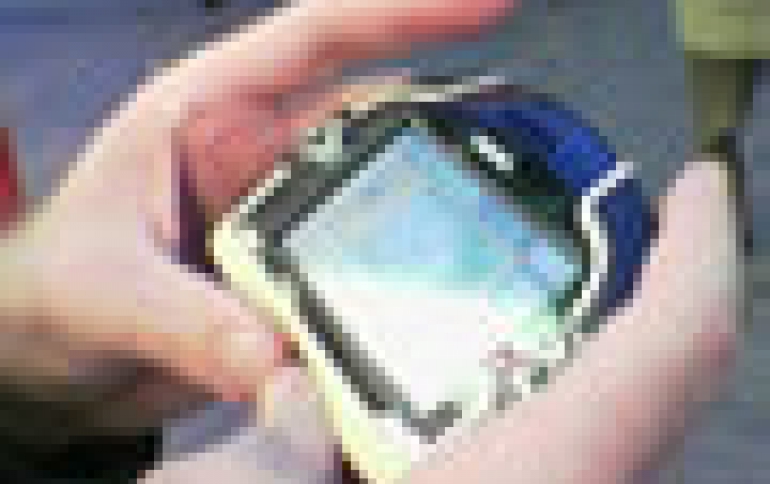
Standards Row Puts Brakes on Mobile TV in Europe
Television addicts soon will simply be able to pick up the set and take it with them, without missing a frame of their favorite program. However in Europe, a row over standards is holding up progress.
Mobile TV is already available on a portable set, laptop or cellphone near you -- at least if you live
in South Korea. Europeans admiring the portable TVs at the world's biggest consumer-electronics fair
in Berlin will have to wait a while.
Handheld TVs with screens measuring some 7 inches diagonally and weighing about 450 grams (1 pound) are perfect for stowing in your bag and are available from Korea's LG Electronics, Samsung and Perstel.
The dinky sets have picture quality comparable with that of standard television, and, with price tags of around $500, are clearly ready for the mass market.
Mobile phones with screens and antennae are also on the market, from LG, Samsung, and Pantech&Curitel.
But, unlike in South Korea -- where mobile TV is already being broadcast and a full commercial service with interactive touch screens is expected to be launched in December -- in Europe, a row over standards is holding up progress.
Klaus Illgner, managing director of Germany's Institut fuer Rundfunktechnik (IRT), the public broadcasters' research institute, says the broadcast and reception technology exists but without the right network mobile television won't happen.
"The whole thing only has a chance if all the parties -- broadcasters, network operators, mobile operators -- work together".
Currently, in Germany, it is possible to receive television signals via handheld devices but the digital DVB-T standard being introduced as analog TV is gradually phased out only has patchy coverage.
In addition, too much movement while watching a program will disturb the signal -- except in cars, where a ready supply of electricity and powerful aerials help.
Illgner says DVB-T, which is scheduled to cover 95 percent of Germany by 2010, was in any case not designed for interactive TV -- which is needed for the premium services that rake in money for operators.
Now the question is whether to build a network with another standard, DVB-H, or whether to use the DMB standard that South Korea uses. Both standards have similar capabilities.
Illgner says the problem will be to thrash out a business model between content providers, infrastructure suppliers and mobile operators.
Meanwhile, DVB-H pilots are being carried out in several European countries by the Broadcast Mobile Convergence Forum, an association whose members include Nokia, Philips and Vodafone.
In Europe, Illgner says, Finland is probably closest to having a functioning mobile television system, with Germany striving to build something that can at least be demonstrated by next year's soccer World Cup.
Assuming the political hurdles can be overcome, there are still technical challenges -- such as the large amount of electricity used by mobile TV, which means that the battery life of most handheld devices is only enough for 2-3 hours' viewing.
Exactly the same problem helped to hold up the mass take-up of 3G, multimedia phones.
Handheld TVs with screens measuring some 7 inches diagonally and weighing about 450 grams (1 pound) are perfect for stowing in your bag and are available from Korea's LG Electronics, Samsung and Perstel.
The dinky sets have picture quality comparable with that of standard television, and, with price tags of around $500, are clearly ready for the mass market.
Mobile phones with screens and antennae are also on the market, from LG, Samsung, and Pantech&Curitel.
But, unlike in South Korea -- where mobile TV is already being broadcast and a full commercial service with interactive touch screens is expected to be launched in December -- in Europe, a row over standards is holding up progress.
Klaus Illgner, managing director of Germany's Institut fuer Rundfunktechnik (IRT), the public broadcasters' research institute, says the broadcast and reception technology exists but without the right network mobile television won't happen.
"The whole thing only has a chance if all the parties -- broadcasters, network operators, mobile operators -- work together".
Currently, in Germany, it is possible to receive television signals via handheld devices but the digital DVB-T standard being introduced as analog TV is gradually phased out only has patchy coverage.
In addition, too much movement while watching a program will disturb the signal -- except in cars, where a ready supply of electricity and powerful aerials help.
Illgner says DVB-T, which is scheduled to cover 95 percent of Germany by 2010, was in any case not designed for interactive TV -- which is needed for the premium services that rake in money for operators.
Now the question is whether to build a network with another standard, DVB-H, or whether to use the DMB standard that South Korea uses. Both standards have similar capabilities.
Illgner says the problem will be to thrash out a business model between content providers, infrastructure suppliers and mobile operators.
Meanwhile, DVB-H pilots are being carried out in several European countries by the Broadcast Mobile Convergence Forum, an association whose members include Nokia, Philips and Vodafone.
In Europe, Illgner says, Finland is probably closest to having a functioning mobile television system, with Germany striving to build something that can at least be demonstrated by next year's soccer World Cup.
Assuming the political hurdles can be overcome, there are still technical challenges -- such as the large amount of electricity used by mobile TV, which means that the battery life of most handheld devices is only enough for 2-3 hours' viewing.
Exactly the same problem helped to hold up the mass take-up of 3G, multimedia phones.













